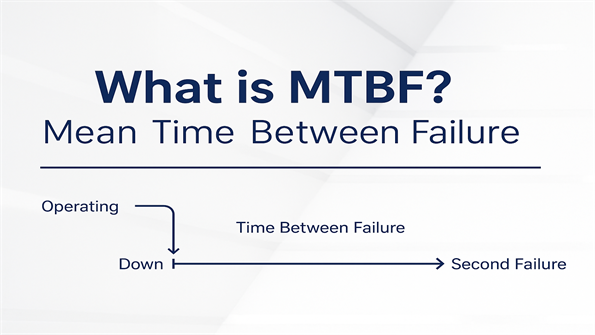What is MTBF (Mean Time Between Failure)?

What is MTBF?
MTBF (Mean Time Between Failure) MTBF, or Mean Time Between Failure, is a measure of how reliably a system or component performs over time. It is used to predict the average time between failures of a machine or system during normal operation. Essentially, MTBF is a key indicator of an item's durability and reliability. It helps measure how well a system performs, how safe it is, and how reliable it is.
The Difference Between MTBF and MTTF
A common point of confusion arises between MTBF and MTTF (Mean Time to Failure). While MTBF applies to systems that can be repaired and returned to service, MTTF is used for non-repairable systems and represents the average time until a system fails completely. Understanding the distinction is essential for proper maintenance planning.
How Do You Calculate Mean Time Between Failures?
Calculating MTBF is simple. Divide the total time the equipment runs by the number of failures in that period. MTBF is usually measured in hours.
MTBF = Total Operation Time / Number of Failures
Here’s how to calculate it step by step:
Find the total uptime: Suppose you test a device that runs 8 hours a day, 5 days a week, for one year. The total operation time is 8 x 5 x 52 = 2,080 hours.
Figure out the number of failures: In that year, the device fails 5 times.
Calculate MTBF: MTBF = 2,080 hours / 5 failures = 416 hours.
This device has an MTBF of 416 hours. This means it may fail around every 416 hours. In reality, failures could happen earlier or later. But MTBF is still an important way to check system reliability.
Why Do We Calculate MTBF?
MTBF helps predict how likely a system is to fail. It is useful for improving reliability and planning maintenance.
• Improve system reliability: MTBF measures how dependable a product is, ensuring long-term stable operation.
• Optimize maintenance schedules: MTBF data helps plan preventive maintenance, reducing unexpected downtime.
• Better resource allocation: Companies can use MTBF to manage staff, spare parts, and budgets efficiently.
• Lower maintenance costs: Predicting failures early helps reduce overall costs.
• Ensure safety & compliance: High MTBF is important in industries like healthcare, transportation, and energy to meet safety standards.
• Support decision-making: MTBF data helps with upgrades, replacements, and technology choices.
• Build customer trust: High MTBF means better product reliability, improving customer satisfaction.
Why is MTBF Important?
MTBF is a critical metric for several reasons:
Performance Metrics
- 1. Reliability Assessment: MTBF is an essential factor in assessing the reliability of equipment. A higher MTBF indicates greater reliability, meaning the equipment is less likely to fail and can operate for longer periods without interruption.
- 2. Maintenance Planning: By understanding MTBF, companies can schedule maintenance activities proactively, preventing unexpected breakdowns. This helps in optimizing maintenance resources and minimizing downtime.
Failure Analysis
Failure analysis is a critical aspect of improving MTBF. By examining the causes of failures, organizations can implement corrective actions to enhance system reliability. Here's how failure analysis works in conjunction with MTBF:
- 1. Identifying Failure Modes: Analyzing failure modes helps in understanding why systems fail. This knowledge can lead to design improvements and better material selection, ultimately increasing MTBF.
- 2. Root Cause Analysis: Identifying the root causes of failures allows organizations to address the underlying issues rather than just treating symptoms. This approach leads to more effective solutions and longer-lasting equipment.
- 3. Continuous Improvement: By tracking MTBF and conducting regular failure analysis, companies can implement continuous improvement strategies to enhance system performance over time.
What are the Disadvantages of MTBF?
MTBF does not tell the full story. It does not explain why failures happen or how serious they are. Also, some people mistakenly think MTBF is the same as a product’s lifespan.
MTBF is a statistical measure, not the actual lifespan. It is tested in controlled conditions and may not reflect real-world performance. To assess reliability properly, combine MTBF with other data like failure rates and maintenance records.
Improving MTBF
To improve MTBF and enhance system reliability, organizations can adopt several strategies:
-
• Preventive Maintenance
Regular maintenance activities, such as inspections, lubrication, and component replacements, can prevent failures and extend the MTBF of equipment. A well-structured preventive maintenance program is essential for maintaining reliability.
-
• Condition Monitoring
Implementing condition monitoring techniques, such as vibration analysis and thermal imaging, allows organizations to detect early signs of wear and address potential issues before they lead to failure.
-
• Training and Skill Development
Ensuring that maintenance personnel are well-trained and skilled in diagnosing and repairing equipment can significantly impact MTBF. Investing in employee training can lead to better maintenance practices and increased equipment reliability.
How Does InnoAioT Ensure High MTBF for Industrial Panel PCs?
InnoAioT’s industrial panel PCs and displays are designed for different MTBF levels to improve reliability.
• Standard: 30,000 hours MTBF, good for general industrial use.
• Advanced: 50,000 hours MTBF, suitable for tough environments with long operation times.
MTBF, or Mean Time Between Failure, is a vital performance metric that plays a significant role in ensuring the reliability and efficiency of systems and equipment. By understanding and applying MTBF, organizations can enhance their maintenance practices, reduce costs, and improve overall system performance. While MTBF has its limitations, it remains an essential tool for failure analysis and maintenance planning across various industries.
InnoAioT offers different MTBF levels for different needs. Our industrial panel PCs have 30,000 hours MTBF, while waterproof PCs have 50,000 hours MTBF for 24/7 operation. If you need high-MTBF industrial panel PCs, InnoAioT’s solutions can help.
